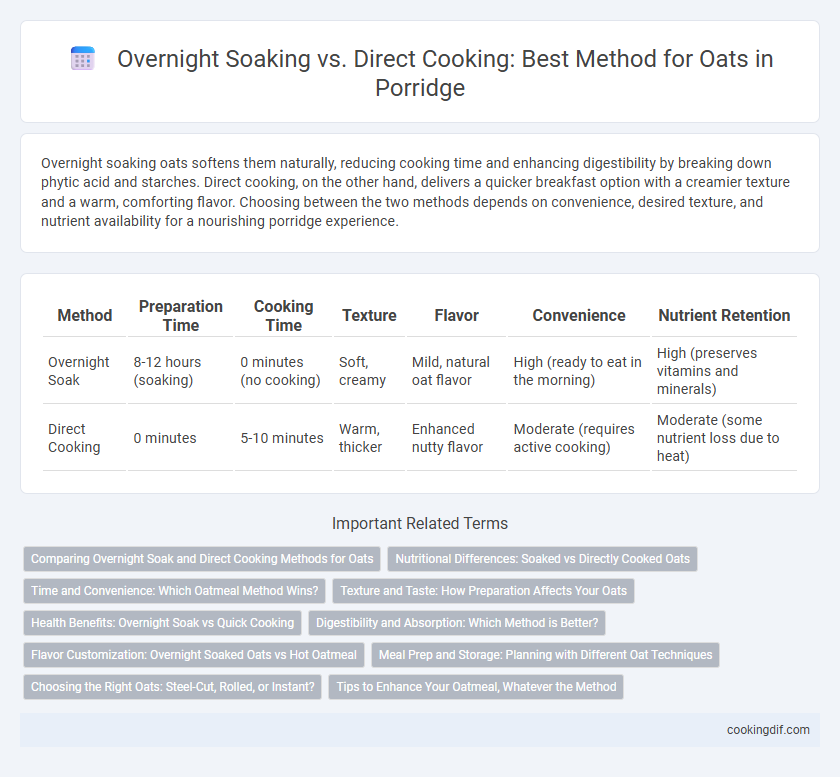Overnight soaking oats softens them naturally, reducing cooking time and enhancing digestibility by breaking down phytic acid and starches. Direct cooking, on the other hand, delivers a quicker breakfast option with a creamier texture and a warm, comforting flavor. Choosing between the two methods depends on convenience, desired texture, and nutrient availability for a nourishing porridge experience.
Table of Comparison
| Method | Preparation Time | Cooking Time | Texture | Flavor | Convenience | Nutrient Retention |
|---|---|---|---|---|---|---|
| Overnight Soak | 8-12 hours (soaking) | 0 minutes (no cooking) | Soft, creamy | Mild, natural oat flavor | High (ready to eat in the morning) | High (preserves vitamins and minerals) |
| Direct Cooking | 0 minutes | 5-10 minutes | Warm, thicker | Enhanced nutty flavor | Moderate (requires active cooking) | Moderate (some nutrient loss due to heat) |
Comparing Overnight Soak and Direct Cooking Methods for Oats
Overnight soaking oats enhances digestibility by breaking down phytic acid and reduces cooking time, making it a convenient method for quick breakfasts. Direct cooking heats oats immediately, offering a faster, warm meal with a creamier texture but may reduce some nutrient availability due to heat exposure. Choosing overnight soaking preserves more nutrients and promotes better digestion, while direct cooking suits those seeking immediate, hot porridge with a rich consistency.
Nutritional Differences: Soaked vs Directly Cooked Oats
Overnight soaking oats enhances nutrient absorption by reducing phytic acid, which can inhibit mineral uptake, whereas direct cooking preserves more water-soluble vitamins like B vitamins due to shorter heat exposure. Soaked oats often have higher bioavailability of minerals such as iron, zinc, and calcium compared to directly cooked oats. Both methods maintain similar macronutrient profiles, but soaking improves digestion and nutrient bioavailability without significantly altering calorie or protein content.
Time and Convenience: Which Oatmeal Method Wins?
Overnight soaking oats requires minimal morning effort, as the grains absorb liquid and soften over 8-12 hours, making it ideal for busy schedules. Direct cooking takes 5-10 minutes, offering quick preparation but demands active attention during cooking. For convenience, overnight soak wins by saving time in the morning, while direct cooking suits those needing faster results without prior planning.
Texture and Taste: How Preparation Affects Your Oats
Overnight soaking oats results in a creamier texture and enhances natural sweetness as the grains absorb liquid slowly, creating a smooth and tender porridge. Direct cooking produces a firmer, chewier consistency with a nuttier, slightly toasted flavor due to the heat application, which also shortens preparation time. Choosing between methods depends on whether you prefer a soft, mellow bowl or a hearty, robust taste experience.
Health Benefits: Overnight Soak vs Quick Cooking
Overnight soaking oats enhances nutrient absorption by breaking down phytic acid, improving mineral bioavailability and digestion compared to quick cooking. This method preserves more antioxidants and reduces glycemic index, supporting better blood sugar control and sustained energy release. Quick cooking oats offer convenience but may lead to higher glycemic response and lower nutrient retention, making overnight soaked oats a healthier choice.
Digestibility and Absorption: Which Method is Better?
Overnight soaking oats enhances digestibility by breaking down phytic acid, which inhibits mineral absorption, leading to improved nutrient uptake compared to direct cooking. Soaking activates enzymes and softens oat fibers, facilitating easier digestion and better absorption of vitamins and minerals such as iron and zinc. Direct cooking, while convenient, may retain more anti-nutrients, potentially reducing bioavailability and causing digestive discomfort for some individuals.
Flavor Customization: Overnight Soaked Oats vs Hot Oatmeal
Overnight soaked oats absorb milk or yogurt, allowing natural flavors like cinnamon, vanilla, and fresh fruits to infuse deeply, resulting in a creamy and subtly sweet taste. Hot oatmeal cooks oats quickly, releasing a nutty aroma and allowing for immediate flavor adjustments through toppings or spices added during cooking. The soaking process enhances smoothness and flavor melding, while direct cooking offers a warm, comforting texture with more pronounced, immediate flavors.
Meal Prep and Storage: Planning with Different Oat Techniques
Overnight soaking oats allows them to absorb liquid fully, resulting in a creamy texture ideal for quick meal prep and easy grab-and-go breakfasts. Direct cooking oats, while faster to prepare when hot, may require immediate consumption or refrigeration within two hours to ensure freshness and prevent spoilage. Planning meal prep with overnight oats supports longer storage of up to five days in the refrigerator, whereas cooked oats typically last only three days when properly sealed.
Choosing the Right Oats: Steel-Cut, Rolled, or Instant?
Steel-cut oats benefit from an overnight soak to reduce cooking time and enhance texture, creating a chewy, nutty porridge. Rolled oats, versatile for both soaking and direct cooking, deliver a creamy consistency with quicker preparation than steel-cut varieties. Instant oats require minimal or no soaking, cooking rapidly to form a smooth, softer porridge ideal for convenience without sacrificing nutritional value.
Tips to Enhance Your Oatmeal, Whatever the Method
Soaking oats overnight softens the grains and reduces cooking time, while direct cooking offers a quicker preparation with a chewier texture. To enhance your oatmeal, incorporate ingredients such as chia seeds, cinnamon, and a pinch of salt for depth of flavor and nutritional benefits. Finished oatmeal can be topped with fresh fruits, nuts, or a drizzle of honey to boost both taste and texture regardless of the cooking method.
Overnight soak vs direct cooking for oats Infographic

 cookingdif.com
cookingdif.com